- Center on Health Equity & Access
- Clinical
- Health Care Cost
- Health Care Delivery
- Insurance
- Policy
- Technology
- Value-Based Care
Translating Clinical Evidence Into Value-Based Payment Models: Pooled Analyses of Innovative Real-World Outcomes Agreements for Ticagrelor in the United States
ABSTRACT
Innovative value strategies for reimbursement of medications include value-based agreements (VBAs) between payers and pharmaceutical manufacturers, which have the potential to improve affordability and patient access to therapy, as well as lead to a reduction in downstream health events and associated medical costs. VBAs link payment for a medication to its performance in real-world clinical practice measured against prespecified outcomes that are aligned to existing evidence. Given its high prevalence, economic burden, and impact on mortality, cardiovascular disease (namely, coronary heart disease) represents an opportunity for VBAs to contribute to improved health outcomes and patient experiences while reducing or containing total medical costs. AstraZeneca developed a VBA framework directly comparing 2 antiplatelet therapies indicated to treat acute coronary syndrome (ACS)—ticagrelor and clopidogrel—based on the PLATO trial, which demonstrated superiority for ticagrelor in reducing the incidence of recurrent myocardial infarction (MI) in patients with ACS. Between 2015 and 2018, 11 contract-years of VBAs utilizing this framework were implemented in commercial and Part D health insurance plans, totaling nearly 32,000 unique patients in which pooled analyses were conducted. Aggregated VBA results indicate that ticagrelor consistently outperformed expectations in reducing recurrent MI vs clopidogrel, while also illustrating how comparative VBA frameworks of this nature may overcome challenges noted for VBAs and be utilized more broadly in future applications.
Am J Manag Care. 2020;26:S275-S286. https://doi.org/10.37765/ajmc.2020.88519
For author information and disclosures, see end of text
Introduction
Over the past decade, development of value-based payment models in health care has evolved and grown across the United States to support determination of fair payment for services or therapies with proven benefit.1,2 Various forms of value-based agreements (VBAs) between health insurers and providers have been in place for decades,3 such as pay-for-performance programs incentivizing providers to align with certain treatment pathways, or rewarding or penalizing systems based on their performance in achieving targets for measures of quality.4 More recently, however, innovative value strategies, which include VBAs, have been increasing in popularity between pharmaceutical manufacturers and insurers, or health systems, as well. These agreements often tie reimbursement of a new or safer and more efficacious therapy to its performance on prespecified expectations for patient health outcomes in a targeted member population.4 In financial terms, VBAs are commonly structured as outcomes-based supplemental rebates that a manufacturer is at risk for paying based on product performance during a contract-year, often on top of a negotiated base access rebate.5 Conceptually, VBAs have the potential to improve patient access to and affordability of safer or more efficacious therapies while reducing the risk that payers have associated with higher acquisition costs and uncertainty over clinical outcomes. VBAs also provide all stakeholders with real-world insight on therapeutic effectiveness and/or impact to health care costs outside controlled clinical trials.6-10 As an insurer increases its willingness to absorb a greater proportion of pharmacy acquisition costs up front, thereby enabling patients greater access to therapy, it is guaranteed a certain level of prespecified outcomes improvement by a manufacturer in return. If that improvement is not achieved, the insurer receives some, or all, of its money back.11
Methodological and Implementation Challenges With VBAs
Determination of Value Measurement
Despite the promise of VBAs and their growth over the past decade, challenges remain, affecting their development and uptake. First, it can be difficult for all stakeholders to align on an outcome measure that is credible and meaningful enough in its determination of “value” to warrant inclusion in a VBA. This can be especially challenging for new product launches, as often the primary outcome contained in randomized controlled trials (RCTs) designed for regulatory decisions are not the highest priority for payer decision-making. High-quality, meaningful outcomes within a VBA should be those that occur with relatively high frequency and are consequential to both the payer (in terms of cost per event and total budget impact) and patient (in terms of individual morbidity and population wellbeing).12,13 They should be measurable from readily available claims or other real-world data (RWD) sources at the payer level, as well as within a time frame that aligns to the length of the contract period between a payer and manufacturer.1 Further alignment between parties is also required to ensure that outcomes selected for a VBA are those that define value in a credible manner by being directly linked to a product’s evidence base from RCT and/or real-world evidence (RWE) study perspectives.
Logistics and Data Analysis
VBAs also may be complicated by the difficulties of assigning responsibility for the workload and costs associated with the sourcing, administration, collection,1 programming, and analysis of RWD, as well as the reporting of results. The skill sets and capabilities needed to perform such activities can be scarce and expensive, which further constrains opportunities.9 Additionally, the portability of terms in a VBA, or otherwise accounting for beneficiaries who may move between insurance plans in a given contract-year, is a concern that many payers have.3 This is important to address within the terms of a VBA, because plan members may change employment during the year and/or a plan’s employer base may shift considerably during new enrollment periods. This may create a situation in which the timing and length of a VBA pose disproportionately high risk to the payer if up-front acquisition costs (ie, increased pharmacy costs) for a new therapy are made, yet terms within a VBA do not allow that patient’s data to be eligible to be included in the VBA analysis, and/or if that patient’s prescriptions are not subject to supplemental rebates paid by the manufacturer based on the results of the VBA.1 Similarly, sample sizes for populations included in VBA analyses may be impacted by member mobility, with smaller sample sizes potentially increasing risk for all parties, as even a small number of outliers can cause considerable skewing of VBA results.14 Therefore, consideration must be given to minimum sample size thresholds agreed to by all parties a priori, above which would represent an acceptable sample size required to protect results from (or to mitigate) skewing or bias inherent with RWD. Commonly, this threshold must also be met in order for VBA results to impact supplemental rebates, which would be paid by a manufacturer.8,15
Results from a 2017 Academy of Managed Care Pharmacy survey indicated that the inability to obtain RWD necessary to accurately define outcome measures was the limiting factor to implementing VBAs most frequently identified (73%) by manufacturers.10 In addition to the outcome measures and raw data elements themselves, a challenging area for manufacturers and payers to align are the actual calculations and analytic methodologies in a VBA framework, which frequently employ structured yet unadjusted statistics to monitor product performance.15,16 These observational, descriptive methods are utilized largely for reasons of feasibility, as they offer the benefit of reducing workload by not having to re-create or replicate a robust clinical or RWE study that would require a considerable number of staff with highly technical skill sets. Yet, by definition, this approach further exposes VBA analyses to the impact of skewing by outliers and/or channeling bias, which may increase risk for all parties by yielding results in either direction that have nothing to do with product effectiveness. Furthermore, available data elements may vary widely from payer to payer and/or not match those that were adjusted for in RCTs and RWE studies. Therefore, replication of formal study methodologies for VBA purposes may not be possible, even with available staff and other resources. These remain prime areas within value-based reimbursement where future research, innovation, and standardization are warranted by academic and industry stakeholders.
The results of a subsequent survey (2019) of manufacturers and payers by Mahendraratnam and colleagues showed that, although actual implementation of VBAs remains relatively low, the interest in and dialogue surrounding VBAs remain quite high.9 Manufacturers and payers reported that only about 33% and 60% of early dialogues, respectively, translate into signed VBA contracts, with various reasons frequently related to misalignment in strategic priorities identified as the major cause for breakdowns in VBA negotiation processes.9 This suggests that although VBAs are seen as a logical next step in the evolution of pharmaceutical reimbursement, much work remains to address these barriers. When barriers are addressed collaboratively by payers and manufacturers, a greater number of VBAs are likely to be seen through to completion.15 Because of the uncertainties and troubleshooting, which may arise as data are collected and analyzed in a VBA—especially at the beginning of a new VBA partnership—a primary challenge for drug manufacturers and payers to overcome is establishing and building trust.1,17 Each side must demonstrate that they intend to act in good faith toward a fair process for developing a framework and interpreting the results of a VBA analysis, and that equitable risk is being assumed by both parties as they aim to improve access to care.15
Regulatory, Compliance, and Legal Considerations
Pharmaceutical manufacturers must be cautious in navigating the antikickback statute of the Social Security Act, as various conditions and framework structures negotiated for VBA data analyses (eg, “eligibility criteria” determining inclusion of patient data related to adherence levels, measurement intervals, and event identification) could be misconstrued as inducing or incentivizing inappropriate use even when the outcome itself is on-label.1,18 Additionally, although the use of RWD to demonstrate medical cost or total cost offsets has potential for application in a VBA, economic outcomes are not typically part of an FDA-approved label, and they may be only indirectly related to an on-label outcome.
Furthermore, medications in disease states where an outcome of interest is a long-term measure requiring multiple years of follow-up for events to accumulate have the added challenge of adjudication and/or resolution of rebate terms within that VBA measurement and reporting period. In many instances, even when a payer is willing to accept delayed payment of outcomes-based supplemental rebates beyond the contract period, manufacturers may be hesitant to engage because of risk for inadvertent implications or unintended consequences on average sales price and/or average manufacturer price, which may impact government reimbursement rates in unknown ways and/or necessitate complex, laborious enforcement retroactively.15
Transparency in VBA Development and Reporting
Although dialogue and implementation of VBAs between payers and manufacturers are becoming more common, most are not made public for a variety of strategic and practical reasons.9 Of the approximate 200 VBAs of various types that have been publicly disclosed globally between 1994 and 2017, nearly 50 were based in the United States, where the primary mechanism for communicating the existence of these agreements has been via press release after initial signing of a VBA.3 Press releases most often contain few, if any, specifics or details on actual methods required to build outcomes definitions (eg, code mapping, calculations) within the analytic framework, nor the end results and ultimate impact of the VBA to population health.19 As sharing of this information through credible, independently verified (eg, peer-reviewed) channels is essentially nonexistent, opportunities for collective learning among stakeholders through a transparent dialogue on VBA best practices have been limited.15 This has resulted in the persistence of methodological challenges; delayed or inhibited opportunities to evolve approaches needed to create higher-quality, more feasible, and efficient VBAs; and increased frustration as barriers to implementation are often repeated and may cause stakeholders to ultimately question whether VBAs are worth the effort to implement.15
A Novel, Transparent Framework for Selecting High-Quality Outcomes in a VBA
The ultimate success of a VBA fundamentally depends on selecting the right outcome measure. In parallel to the paucity of shared detailed information on the analytic construct and results of existing VBAs in the marketplace, there is largely an absence of guidance documentation offered publicly from the manufacturer perspective on their internal VBA development process, which has been opened to critique by academic or other industry experts. Such documentation would be very useful for developers of VBAs to reference and consult when attempting to identify and select an appropriate outcome measure, or to prioritize and then choose from several potential outcomes, in a clear and transparent manner.16 In this analysis, an attempt is made to begin filling this void by presenting a 5-pronged set of criteria, which were used to develop the VBA framework for ticagrelor in patients with acute coronary syndrome (ACS).
A high-quality outcome measure in a VBA, applied equally to the drug of interest, as well as any comparator group, should satisfy the following criteria to the highest degree possible: It should be (1) credible, (2) meaningful, (3) practical, (4) transferable, and (5) compliant (legal) (Table 1).
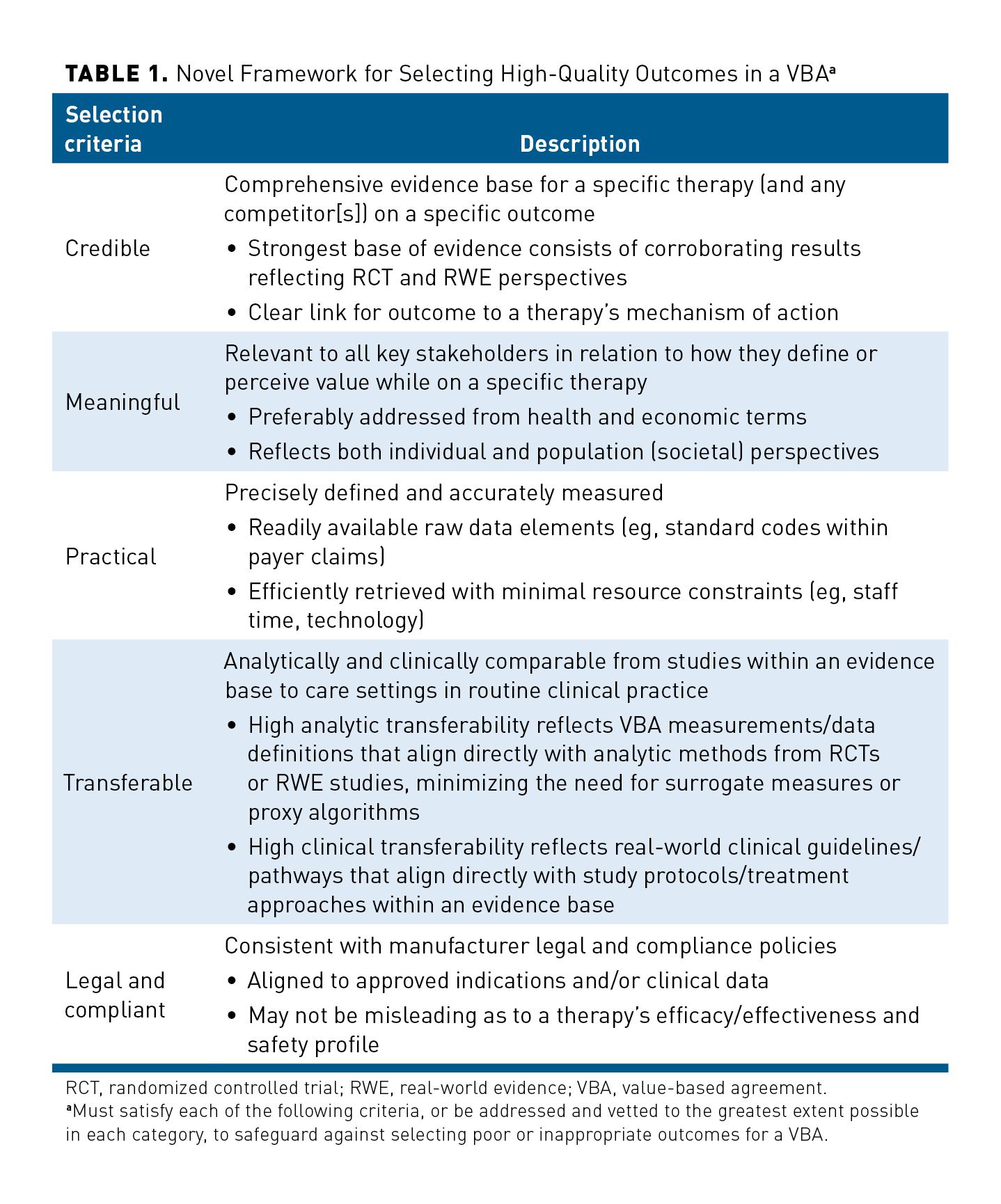
For the outcome to be credible, it must have a comprehensive and corroborating base of evidence, preferably from the perspective of both RCT and RWE studies. The mechanism of action for the drug of interest (and any comparators) should be well established regarding its impact on the outcome or health event in a targeted population, proven through preclinical and/or phase 2 and phase 3 studies.
Outcomes for a VBA should also be meaningful to all stakeholders, including patients. Such outcomes commonly include health events or other hard end points, the avoidance of which would represent a major milestone of improvement in patient health, and for which a direct, significant cost to payers would be incurred per event. These outcomes should occur with high enough frequency to represent a serious concern to population health, and to have a budgetary impact that would be unsustainable for payers to absorb in perpetuity. It is not necessary for a VBA outcome to be the same as the primary outcome measured in an RCT designed for regulatory decisions, but VBA outcomes should be related to key secondary outcomes and/or to have been a main focal point for exploration in well-structured RWE studies. For example, although lab values or other intermediate clinical biomarkers may be important outcomes within an RCT, the downstream health outcome or hard end point related to that biomarker or lab value could be more meaningful to all stakeholders within a VBA. An example of this would include measurement of glycated hemoglobin vs the downstream diabetes- and cardiovascular-related benefits, such as reduction in cardiovascular disease (CVD)-related death, heart failure, or myocardial infarction (MI).20,21
The third component for selecting a high-quality outcome measure within a VBA relates to its practicality or feasibility—in other words, how efficient or straightforward it is to capture or retrieve the necessary codes or RWD variables, as well as to utilize them in precisely defining and accurately quantifying an outcome of interest. Several factors have been identified by manufacturers and payers alike as necessary to consider when evaluating the feasibility of measuring a given outcome: (1) a reasonable administrative burden, (2) the availability of often constrained or rare technical skill sets required to conduct analyses on large data sets and to appropriately interpret results, and (3) alignment among the data elements available within a particular payer type to those needed for defining parameters of a particular VBA outcome.9
A fourth component essential to selecting a high-quality VBA outcome pertains to the transferability, or comparability, of that outcome from RCT settings to real-world clinical practice, or from RWE studies conducted in 1 geography to routine care being provided in another. In other words, the outcome used to build the VBA framework should be similar in how it is defined and ascertained analytically from studies in the evidence base to a real-world payer environment, and/or it should mimic how it is addressed and treated by clinicians within studies from the evidence base to the care setting where a VBA is being implemented.22 Furthermore, outcomes must be transferrable regarding the manner in which they are defined, and how precisely the data elements captured in an RCT match those of payer RWD systems.4 If a direct match is not present, outcomes within an RCT that are being explored for VBA purposes must be sensitive to, and able to be well defined by, widely used claims codes and/or validated claims algorithms. Where possible, complex electronic medical record or chart reviews should be avoided. The level of transferability here relates to how well, or not, algorithms applied to pharmacy and/or medical claims can be used to create surrogate or proxy measures for outcomes studied in the evidence base for a medicine.4 Validation of such algorithms intended for VBA purposes represents another area warranting methodological innovation and refinement by academic and industry stakeholders.
Lastly, outcomes in a VBA must be determined to be within compliance policies, adhering to any legal issues that may be unique to the product or manufacturer, and/or be deemed acceptable as covered by existing safe harbors for scientific exchange. Where feasible, outcomes should be aligned to a therapy’s approved indication in a specified population, or where not explicitly on-label, at a minimum they should be clearly tied to a robust and corroborating base of evidence. For example, medications are generally not indicated to improve adherence or to reduce cost of care, yet there are VBAs that exist in the public domain focusing on these outcomes, likely justified with the presence of multiple RWE analyses, which substantiate the scientific grounds on which to set expectations and build an analytic framework. Outcomes in a VBA should not be misleading in their application or unrelated to what the evidence base clearly demonstrates for product effectiveness and safety.1,4,23
Rationale for VBA Development in ACS
Between 2009 and the second half of 2019, 73 publicly announced and executed VBAs were developed based on clinical data or rationales, with 17 in cardiology.24 This focus on CVD is warranted, given that it remains a leading cause of mortality, accounting for more than 30% of all deaths globally (approximately 17.8 million total in 2017, 85% of which were due to MI or stroke).25,26 More specifically, ACS is a particularly challenging health condition to manage, as patients who have had a previous MI have a 5 to 7 times greater risk of having another MI (including increased risk of death) and a 3 to 4 times increased risk of having a stroke.27,28 As such, this area remains active within pharmaceutical research and development for exploring new therapy options.
The economic burden of CVD is also well established, with average annual direct and indirect costs in the United States—notably for CVD and stroke—estimated at $351.3 billion in 2014 to 2015, the majority of which stem from direct medical costs to treat outcomes ($213.8 billion).25 The promise of VBAs to positively impact medical costs and patient outcomes in CVD care has been recognized by the American College of Cardiology, which convened its first Value-Based Care in Cardiology Forum in December 2019.29
Scientific Foundation for Constructing a VBA for Ticagrelor
In alignment with the criteria for selecting a high-quality outcome measure, a VBA framework was developed for an antiplatelet agent, ticagrelor, based on the findings of the pivotal PLATO study (NCT00391872) in patients with ACS.30,31 PLATO was a multicenter, double-blind, randomized phase 3 trial comparing ticagrelor (Brilinta®; AstraZeneca) (180-mg loading dose, 90 mg twice daily thereafter) directly with clopidogrel (300-mg to 600-mg loading dose, 75 mg daily thereafter) for the prevention of cardiovascular events in 18,624 patients admitted to the hospital with ACS, with or without ST-segment elevation.32 Results indicated that at 12 months, the primary composite end point—cardiovascular death, MI, or stroke—occurred in 9.8% of patients receiving ticagrelor compared with 11.7% of those receiving clopidogrel (HR, 0.84; 95% CI, 0.77-0.92; P < .001), representing a 16% relative risk reduction (RRR) favoring ticagrelor. In predefined hierarchical testing, the benefit demonstrated for ticagrelor was shown to be driven by cardiovascular death and recurrent MI, with no difference in stroke; specifically for recurrent MI, events occurred in 5.8% of patients who received ticagrelor vs 6.9% of patients who received clopidogrel (P = .005), similarly representing a 16% RRR. The rate of death from any cause—considered an exploratory end point due to the nature of the hierarchical statistical approach—was also reduced with ticagrelor (4.5% vs 5.9% with clopidogrel; P < .001). In PLATO, the treatment benefit vs clopidogrel was first tested and confirmed at 30 days post discharge from patients’ index ACS event, with the magnitude of effect continuing to increase in favor of ticagrelor throughout the 12-month treatment period. No significant difference in the rates of major bleeding was found between ticagrelor and clopidogrel (11.6% and 11.2%, respectively; P = .43), although ticagrelor was associated with a higher rate of major bleeding not related to coronary artery bypass grafting (4.5% vs 3.8%; P = .03), including more instances of fatal intracranial bleeding but fewer instances of fatal bleeding of other types. Rates of reported medication adherence in PLATO were higher than 80% for both ticagrelor and clopidogrel.32 Guidelines from the American College of Cardiology and the American Heart Association recommend ticagrelor over clopidogrel in patients with ACS/ST-segment elevation myocardial infarction (STEMI), whether they are treated with stent placement or medical therapy alone.33
Pooled Outcomes Analyses of VBAs for Ticagrelor
Given the need to drive increased dialogue and to provide details on the development and ultimate impact of VBAs, analyses of aggregate data leading to pooled outcomes results from VBAs with a common analytic framework implemented for ticagrelor across several payer types were conducted. The objective of these analyses, and this paper more broadly, is to transparently describe the development, implementation, and analytic process, as well as results, from completed VBAs for ticagrelor within US payer settings.
Methods
Consistent with PLATO study results and the FDA-approved indication for ticagrelor,31 a VBA framework was developed based on superiority for ticagrelor over clopidogrel in reducing the risk of a second MI after an initial ACS event. This framework was implemented within national and regional US payer settings, including commercial insurance and Medicare Part D populations. Recurrent MI was chosen as an appropriate outcome for VBA purposes because it satisfied all 5 criteria in our VBA framework development process (Table 1):
- The clinical benefit on recurrent MI for ticagrelor in ACS is linked to a solid foundation of scientific evidence and is compliant in relation to its indicated use.
- It occurs with relative high frequency in the general population, and it is often treated utilizing guidelines-driven protocols that are relevant in RCT and real-world clinical practice settings alike.
- It is practical to measure within a reasonable time period in alignment to the length of follow up in PLATO (ie, a 12-month contract-year).
- It can be accurately and precisely measured utilizing readily available payer claims data.
- It is meaningful to both payers and patients (from a cost and health perspective).
The analytic framework was developed in a stepwise manner, with real-world pharmacy and medical claims data retrieved at the payer level and filtered through a series of eligibility requirements, which allowed for isolated analyses of event rates in treated populations with confirmed ACS diagnoses. This filtering also served to ensure that data included in VBA analyses accurately reflected, and were aligned to, the PLATO study. For example, investigator-reported medication adherence in PLATO was above 80% for both ticagrelor and clopidogrel, and as such, sufficient exposure to therapy measured by claims-based medication adherence (defined as a proportion of days covered [PDC] of at least 80%) was required in order for patients’ data to be included in VBA analyses.32 Only patients who remained adherent to ticagrelor or clopidogrel during the contract period following their index ACS hospitalization were assessed. Appropriate timing of antiplatelet use (initiation within 30 days after the index event), discrete treatment with either ticagrelor or clopidogrel as patients’ dedicated antiplatelet therapy throughout the contract period, and adequate population size (minimum sample size thresholds depending on plan size) because of the unadjusted nature of the analyses, were also required. The 16% RRR demonstrated in PLATO on recurrent MI vs clopidogrel served as the prespecified clinical expectation for ticagrelor within the VBA framework (ie, ticagrelor rates for recurrent MI were required to be at least 0.84 times the rate observed for clopidogrel in the same payer population).32 The potential financial penalties paid to health plans by AstraZeneca if ticagrelor did not meet this prespecified expectation took the form of incremental rebates paid on top of negotiated base access rebates.
The end result of VBA analyses and any subsequent outcomes-based supplemental rebates paid by AstraZeneca were applicable for all patient utilization of ticagrelor during the VBA contract-year, rather than on filled scripts solely among patients meeting VBA eligibility criteria. In addition, patients leaving a health plan at any point during the VBA contract-year were eligible to have their data included for VBA analyses as long as they met all other eligibility criteria. Any supplemental rebates based on underperformance of ticagrelor in the contract period were applied to all ticagrelor utilization up to their leaving date. Claims utilized for VBA analysis were based on actual paid claims. All patients were followed for up to 365 days after their index ACS event, or until the date of their recurrent MI event, whichever came first during the contract period (Figure).
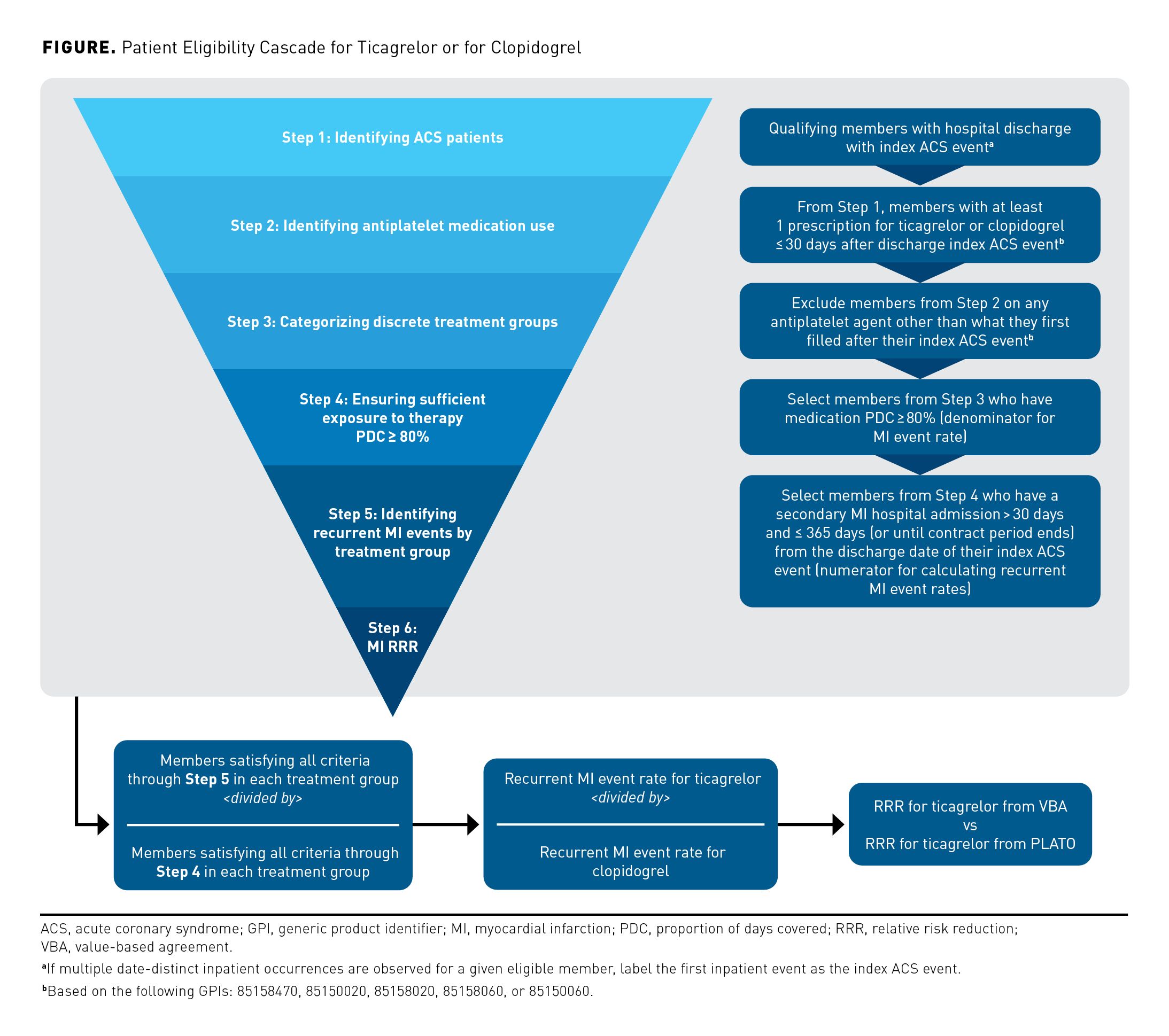
Eligibility criteria for inclusion of patients’ data to the ticagrelor VBA analyses were applied within the VBA analytic framework as follows:
1. Patient diagnoses of ACS were identified according to International Classification of Diseases, Ninth and Tenth Revisions (ICD-9, ICD-10) codes for unstable angina, STEMI, non-ST elevation myocardial infarction (NSTEMI) (ICD-9, ICD-10; ICD-9 used for service claims prior to October 2015) (Table 2).
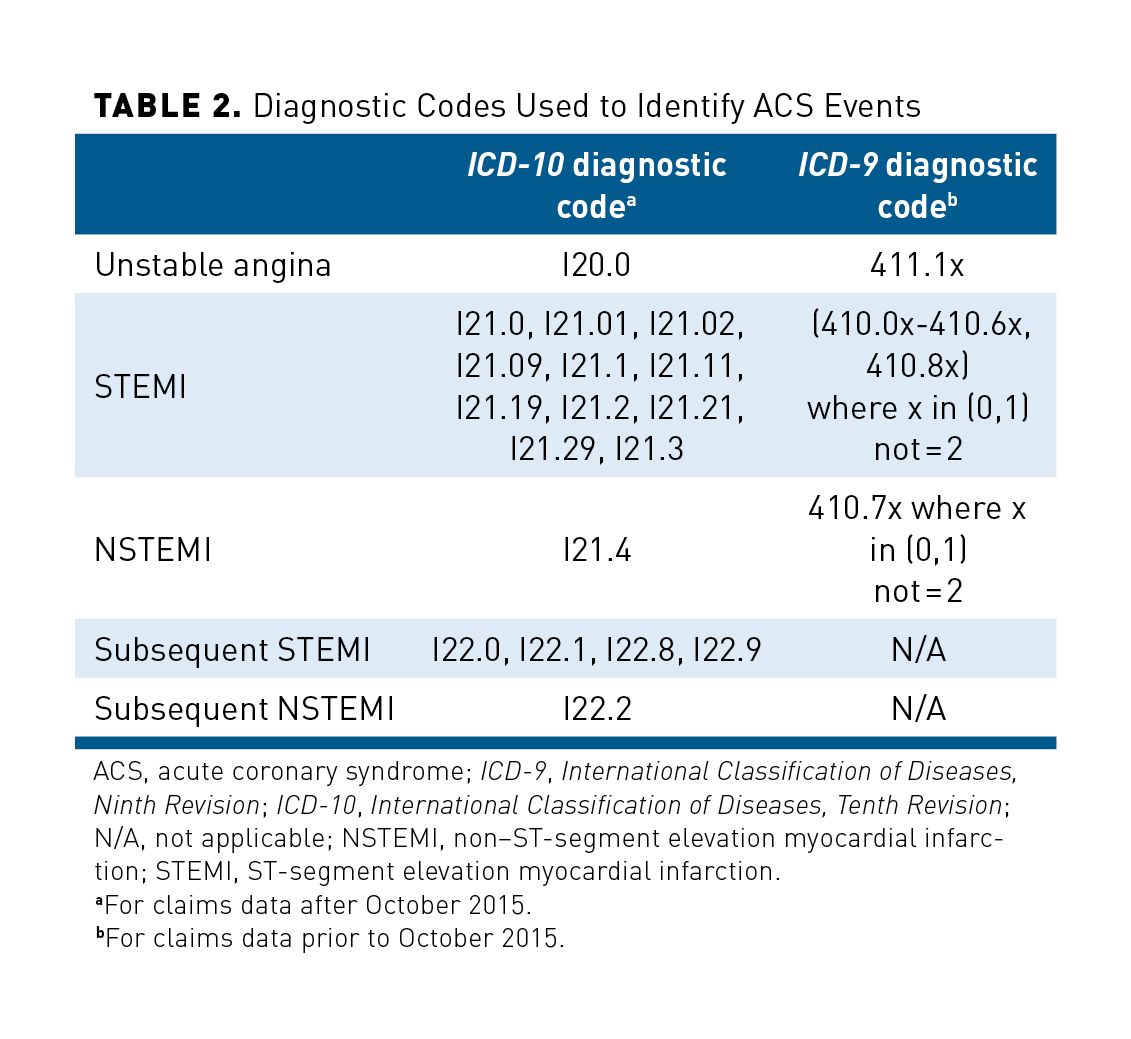
2. The first occurrence of a hospital admission with an ACS diagnosis code in the primary position was labeled as the index ACS event; accordingly, if multiple date-distinct inpatient occurrences were observed, the earliest date served as the index event.
3. Patients received a prescription for first use of ticagrelor or clopidogrel within 30 days post discharge following the index ACS event, identified using applicable national drug codes (NDCs) mapped to specific generic product identifier (GPI) codes. As there are a considerable number of NDC codes present for these products, only the representative GPI codes are provided (Table 3).
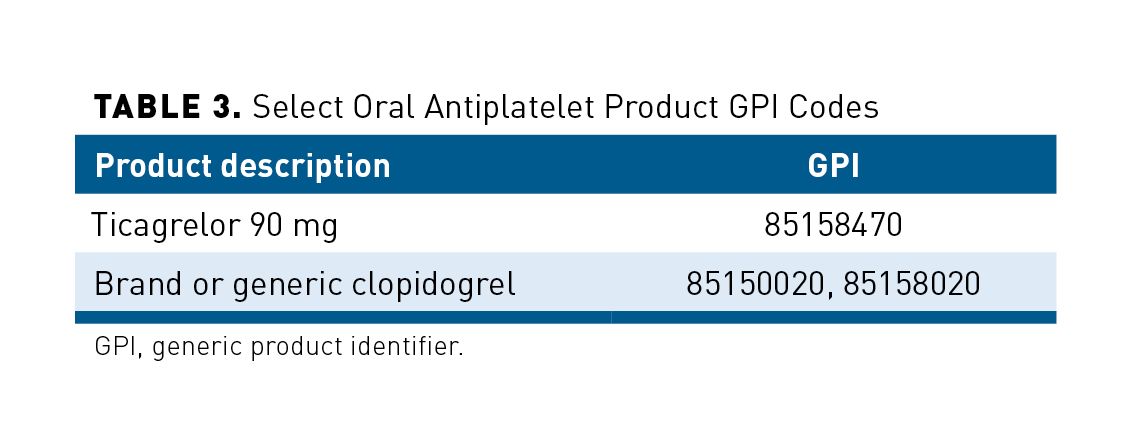
4. Patients were required to be treated with discrete use of either ticagrelor or clopidogrel to ensure no mixing effects, and they were followed until their second MI event or for the remainder of the contract period, whichever occurred first.
5. Patient data were excluded from VBA analysis if any antiplatelet therapy other than that initially used to treat their index ACS was filled by the patient from discharge date of their index event until either the end date of the contract period or date of second MI.
6. Patients on ticagrelor and clopidogrel were required to have a PDC for ticagrelor or clopidogrel at 80% or higher throughout the time period for which they were followed during the contract period after their index event, calculated as follows:
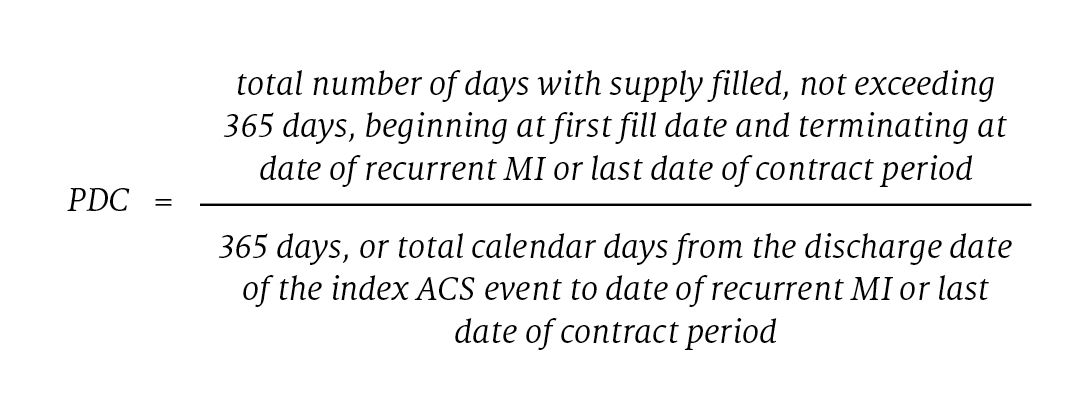
Recurrent MI events within the contract-year were identified by diagnostic codes for subsequent STEMI and subsequent NSTEMI (Table 2), and they were eligible to be included for VBA analysis if they occurred at least 30 days post discharge from the index event (to align with the earliest time point for hierarchical statistical testing within PLATO). Descriptive stepwise analytic methods were applied, with frequencies of recurrent MI events in patients receiving ticagrelor and clopidogrel used to calculate event rates. These rates were then compared with one another in order to generate unadjusted RRRs and absolute risk reductions (ARRs). Calculation of recurrent MI event rates for both treatment groups was performed as follows:
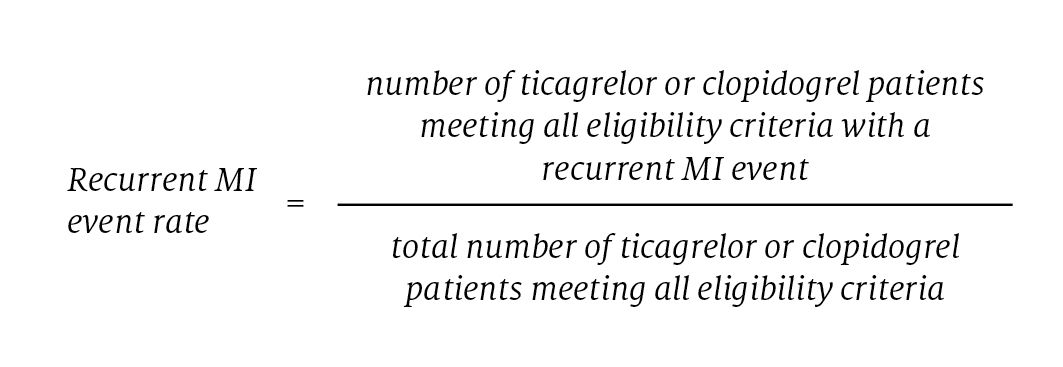
All analytical criteria were applied equally for ticagrelor and clopidogrel and were consistent across all executed VBAs included in this pooled analysis. The eligibility criteria within the VBA analytic framework served to ensure that analyses for individual VBAs were well structured and in alignment with PLATO; however, full statistical adjustment was not conducted (including at the aggregate level when reporting pooled results) due to lack of consistency in available data variables and elements across payer types, as well as powering and sample size limitations.
Results
The ticagrelor VBA framework was implemented across 5 distinct health plans utilizing a common analytic framework and outcomes reporting structure. In all, there were 11 contract-years of VBA experience for ticagrelor implemented across these 5 health plans between 2015 and 2018. Seven of the 11 contract-years (63.6%) were executed within commercially insured ACS patient populations, and the remaining 4 contract-years (36.4%) were within Part D populations. Data capture on patient characteristics was limited mainly to those required for filtering through eligibility criteria enabling measurement of recurrent MI event rates and generating RRR estimates between treatment groups; however, the Medicare Part D population was required to be aged at least 65 years.
Eligible Members and Recurrent MI Event Rates
In aggregate, the total number of unique patients meeting all framework eligibility criteria across plans was 31,946 (n = 25,004 for clopidogrel [Table 4] and n = 6942 for ticagrelor [Table 5]). Of these eligible members analyzed, a total of 1167 had recurrent MI events: 1026 (4.10%) patients treated with clopidogrel and 141 (2.03%) patients treated with ticagrelor (Table 6). Among clopidogrel-eligible patients, 111 of 5712 (1.9%) with commercial coverage and 915 of 19,292 (4.7%) with Medicare Part D coverage had recurrent MI events. Among ticagrelor-eligible patients, recurrent MI events occurred in 45 of 3458 (1.3%) patients with commercial coverage and 96 of 3484 (2.8%) with Medicare Part D coverage.
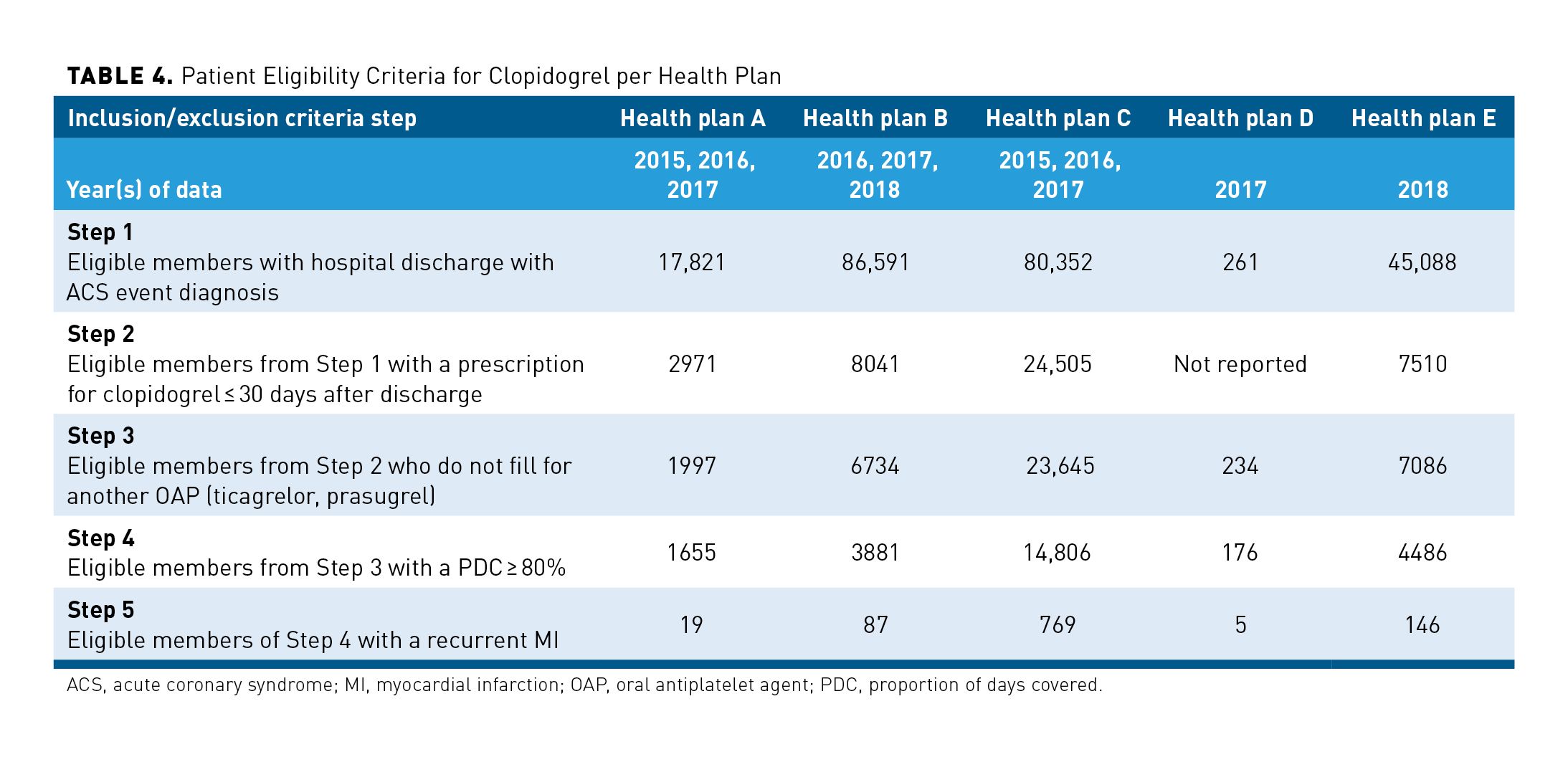
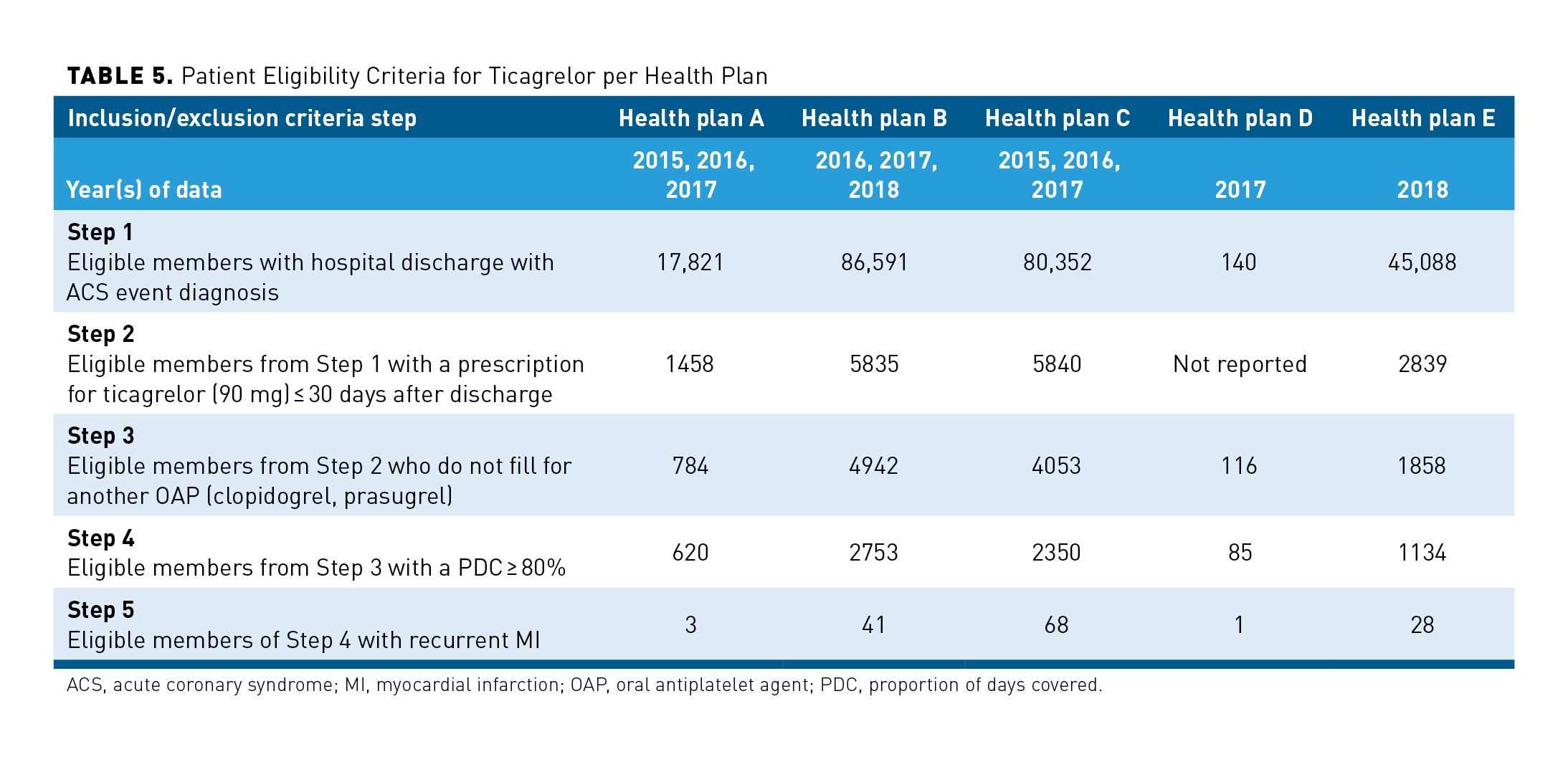

Reduction of Risk for Recurrent MI
Recurrent MI rates were lower with ticagrelor vs clopidogrel across all 5 payers and throughout all 11 contract-years of VBA experience (Table 6), with a mean unadjusted RRR of 50.5% (range, 24.0%- 65.7%) and mean unadjusted ARR of 2.07% (range, 0.43%-3.41%). In the pooled Medicare Part D population, the RRR for recurrent MI was greater than in the pooled commercial insurance population (41.9% and 33.0%, respectively); the ARR was also greater (1.99% and 0.64%, respectively). These differences are possibly related to the Medicare Part D population having higher risk for events due to older age. There were no outcomes-based supplemental rebates paid by AstraZeneca for any of the 11 VBA contract-years included in this analysis, as each surpassed the expectation for an unadjusted RRR of 16%.
Discussion
VBAs: A Potential New Paradigm for Establishing Real-World Cost-Effectiveness
The utility of VBAs to support new mechanisms for negotiating pharmaceutical reimbursement by focusing on evidence-based value, rather than market-based volume, originated from an environment where limited budgets, unsustainable rising health care costs, and the availability of advanced treatments all coexisted. This has led to an increasing level of urgency among all stakeholders to maximize cost-effectiveness in targeted patient populations, and prior to VBAs, payers have relied almost exclusively on formal economic simulations (eg, budget impact analysis, cost-utility modeling) to inform and support cost-effective decision making.34 Conceptually, as increased adoption of VBAs continues to foster improvements and an evolution of value-based reimbursement, payer goals for achieving cost-effectiveness may be accomplished in real, practical terms for certain disease states through VBAs rather than with modeled simulations alone. This could occur by ensuring that VBA frameworks balance increased pharmacy costs for superior therapies with commensurate guarantees on improved health outcomes (resulting in medical cost offsets and/or improved health-related quality of life [HR-QOL], in situations where it is feasible to collect patient-reported outcomes) that would satisfy mutually agreed-upon thresholds for cost-effectiveness over a contracted time period. If those guarantees on health outcomes, medical cost offsets, and/or HR-QOL are not achieved, the rebates or discounts within a VBA applied to the initial prescription cost increases could be established at a level assuring that incremental costs were ultimately low enough to satisfy a cost-effectiveness threshold. In other words, once a payer and manufacturer agree on a threshold reflecting a feasible level of incremental benefit expected for their population over a contract period, terms of a VBA could conceivably be constructed such that the level of risk-sharing by the manufacturer guarantees that a prespecified cost-effectiveness ratio is met, either through an increase in the denominator (incremental benefit defined by expectations on outcomes improvement) or decrease in the numerator (incremental costs reduced by medical offsets or supplemental rebates).
It is unlikely that VBAs will or can replace formal economic simulations used for decision making, or that a conceptual VBA approach for demonstrating cost-effectiveness is possible within all disease states or therapeutic categories. However, where feasible, it is an approach that warrants continued exploration and piloting of case studies. It is well established that this approach may not work for certain chronic conditions, as the relatively short time frame of a VBA contract period does not align with the lifetime need for medication nor the need for treatment changes and augmentation that occur as disease becomes more severe over time. Furthermore, the positive effect of chronic medications on morbidity and mortality are not usually seen over short time frames.4,35 However, this may be a relevant concept for conditions for which risk for costly health events is a short-term concern, and/or for therapy areas in which a medicine offers “on demand” risk reduction or symptom relief.
Methodological Innovation and Data Interpretation for VBAs
Developing a more supportive environment to facilitate innovation for VBA methods is crucial for improvement of value-based reimbursement for pharmaceuticals. This depends largely on independent scrutiny and collective inquiry into existing frameworks to understand what has worked well in specific patient populations, and why. RWE is an important component of the evidence base of many VBA frameworks, and it plays a unique role in supporting health care decision making by yielding insights not addressed in RCTs.36 Unlike RCTs, however, even when conducted with a robust, widely accepted methodology that is well represented in the literature, RWE studies routinely utilize data captured in an uncontrolled environment, often lacking granular levels of clinical detail in RCTs. Similarly, RWD analyzed for VBA purposes are generated from uncontrolled clinical care settings and retrieved at the payer level. For reasons of practicality and feasibility in a VBA context, statistical analysis of those RWD are descriptive and observational, and only the minimum required data elements are collected for measuring and analyzing the outcome of interest. This leaves patient information variables (eg, sociodemographic factors, level of comorbidity, history of resource use, concomitant medications) largely out of the equation and thereby limits the potential for adjustment of confounders in a VBA. Furthermore, RWD environments and the availability of potentially important confounding variables can vary widely among payers, creating additional challenges to adopting a more robust statistical approach when conducting VBA analyses, especially at the aggregate level.37
These differences not only make it difficult to design VBA analyses that mirror the analyses within RCT or robust RWE studies, but it is also inappropriate to make direct comparisons between VBA results and RCT or RWE results. VBAs are currently designed to serve as an opportunity to gain observational insight into product performance in a manner that provides those who directly pay for pharmaceuticals with a high degree of confidence that the medicine is generally working “as advertised” in their own population in relation to a base of evidence that already exists. The goal for VBAs is not to generate new formal evidence aimed to confirm cause and effect or to identify statistically significant associations between product use and a specific outcome. Although this article aims in part to propose a novel, simplified development framework from the manufacturer perspective that may be used to inform selection of high-quality outcomes in a VBA, and to demonstrate with transparency how the VBA framework built for ticagrelor satisfies those criteria, much work is still needed to overcome data- and methodology-related challenges with VBAs in general. These efforts should be focused on pragmatic ways to expand RWD collection for VBA purposes to allow more comprehensive analytics to be conducted, as well as on the development of new statistical techniques that are more efficient than those used in RCT or formal RWE studies, yet are stronger than the purely descriptive techniques used today. The increased focus on creating, adopting, and standardizing improved methods for VBAs should also be accompanied by an increased willingness among manufacturers and payers alike to publish results of VBAs, enabling dialogue that will lead to a better experience with VBAs among all stakeholders, including health care providers and patients.
Proposal on a New Regulatory Landscape for VBAs
More specific guidance and clarity on the rules of engagement for VBAs, through sanctioning or creation of new safe harbors and/or regulations by government authorities (eg, FDA, CMS, the Office of Inspector General for the US Department of Health & Human Services), or even the advent of an independent arbitration process for vetting appropriateness of VBA designs, would foster opportunities for pharmaceutical manufacturers and payers to experiment more aggressively, drive more comprehensive dialogues, and thereby accelerate progress in this area. CMS acknowledged in June 2020 the decades-old nature of regulatory requirements in the Medicaid Drug Rebate Program, noting that existing regulations are outdated and not adequate for enabling a reimbursement environment that increasingly focuses on value-based payments, because that is not what the regulatory requirements were originally created for.38 Accordingly, promising steps have now been taken to introduce several policy and legislative proposals that are specifically intended to foster innovation for value-based payment models; they address, for instance, the need for longer follow-up periods for outcomes observations in VBAs, and add clarity on how average manufacturer price, average sale prices, and Best Price impacting Medicaid pricing should be calculated in a VBA context. Legislation at the state level related to pharmaceutical pricing transparency requirements—which are not standardized across the United States—as well as varying degrees of interest and action taken by states to apply for value-based supplemental CMS waivers, further complicates matters for manufacturers as they seek to understand and mitigate areas of risk when formulating innovative value strategies.39 Final details are yet to be fully worked through, and a timeline for enacting any proposals is unknown at this point; however, this is eagerly anticipated by numerous stakeholders.
Limitations
This pooled analysis utilized an observational design and descriptive techniques using RWD collected across multiple payer databases that are nonstandardized. As there are no statistical adjustments made in VBA analyses, it is not appropriate to make direct comparisons or to categorically conclude that VBA results mirror what was proven in RCTs. The VBA eligibility criteria applied to the ticagrelor VBA framework were aimed at structuring VBA analyses to the PLATO trial to the best of their ability, but there is not a perfect overlap with the types and proportions of patients enrolled in PLATO to those meeting eligibility requirements in this real-world VBA. It is unknown to what extent the statistical adjustment of confounders may have altered results.
Conclusions
VBAs represent an important and increasingly frequent option for innovative reimbursement models that link clinical evidence for a medicine to payment terms. Experience to date with ticagrelor further demonstrates the feasibility of VBAs across payer types. Challenges remain, and continued transparency and dialogue on advances in VBA methodologies and framework development processes would benefit all stakeholders. To our knowledge, this pooled analysis is the first of its kind and provides pragmatic insight on the utility of ticagrelor in comparison with clopidogrel in an on-treatment, adherent, and wide-ranging population of real-world patients with ACS who are at risk for a subsequent MI. The unadjusted event rate for recurrent MI in this analysis was consistently lower among patients treated with ticagrelor than those treated with clopidogrel. However, it is unknown to what extent statistical adjustment of confounders may alter results. Outcomes observed with ticagrelor in this real-world pooled analysis suggest that results from RCTs can be applied in a VBA context to support payer decision-making and bring value to clinical practice.
Author Affiliations: AstraZeneca (DB, NA, DAB, NB, NDK, DSC); Genentech (DSC).
Funding Source: Financial support for this work was provided by AstraZeneca.
Author Disclosures: Mr Bhandary is employed by and owns stock in AstraZeneca and has attended meetings and conferences such as AHA and AMCP. Dr Atreja, Mr Belleti, Dr Bhalla, and Dr Khan are employed by and own stock in AstraZeneca. Dr Cobden was previously employed by AstraZeneca, owns stock in AstraZeneca, and is currently employed by Genentech.
Authorship Information: Concept and design (DB, NA, NB, NDK, DSC); acquisition of data (NA, NDK, DSC); analysis and interpretation of data (DB, NA, DAB, NB, NDK, DSC); drafting of the manuscript (NA, DAB, NB, DSC); critical revision of the manuscript for important intellectual content (DB, NA, DAB, NB, NDK, DSC); statistical analysis (NA, DSC); provision of study materials (NA, DSC); obtaining funding (NA, NDK, DSC); administrative, technical, or logistical support (DB, NA, DSC); supervision (NA, NDK, DSC).
Address correspondence to: David S. Cobden, PhD, MPH, MSc, MBA, AstraZeneca, 13 Lawson Rd, Sand Lake, NY 12153. Email: dscobden@yahoo.com.
References
1. Branning G, Lynch M, Hayes K. Value-based agreements in healthcare: willingness versus ability. Am Health Drug Benefits. 2019;12(5):232-234.
2. Mendelson A, Kondo K, Damberg C, et al. The effects of pay-for-performance programs on health, health care use, and processes of care: a systematic review. Ann Intern Med. 2017;166(5):341-353. doi:10.7326/M16-1881
3. Chatterjee A, Dougan C, Tevelow BJ, Zamani A. Innovative pharma contracts: when do value-based arrangements work? McKinsey & Company. October 19, 2017. Accessed September 30, 2020. https://www.mckinsey.com/industries/pharmaceuticals-and-medical-products/our-insights/innovativepharma- contracts-when-do-value-based-arrangements-work
4. AMCP Partnership Forum: advancing value-based contracting. J Manag Care Spec Pharm. 2017;23(11):1096-1102. doi:10.18553/jmcp.2017.17342
5. Kannarkat JT, Good CB, Kelly E, Parekh N. Examining misaligned incentives for payers and manufacturers in value-based pharmaceutical contracts. J Manag Care Spec Pharm. 2020;26(1):63-66. doi:10.18553/jmcp.2020.26.1.63
6. Yu JS, Chin L, Oh J, Farias J. Performance-based risk-sharing arrangements for pharmaceutical products in the United States: a systematic review. J Manag Care Spec Pharm. 2017;23(10):1028-1040. doi:10.18553/jmcp.2017.23.10.1028
7. Brown JD, Sheer R, Pasquale M, et al. Payer and pharmaceutical manufacturer considerations for outcomes-based agreements in the United States. Value Health. 2018;21(1):33-40. doi:10.1016/j.jval.2017.07.009
8. Kannarkat JT, Good CB, Parekh N. Value-based pharmaceutical contracts: value for whom? Value Health. 2020;23(2):154-156. doi:10.1016/j.jval.2019.10.009
9. Mahendraratnam N, Sorenson C, Richardson E, et al. Value-based arrangements may be more prevalent than assumed. Am J Manag Care. 2019;25(2):70-76.
10. Duhig AM, Saha S, Smith S, Kaufman S, Hughes J. The current status of outcomes-based contracting for manufacturers and payers: an AMCP membership survey. J Manag Care Spec Pharm. 2018;24(5):410-415. doi:10.18553/jmcp.2017.16326
11. Zaric GS, Xie B. The impact of two pharmaceutical risk-sharing agreements on pricing, promotion, and net health benefits. Value Health. 2009;12(5):838-845. doi:10.1111/j.1524-4733.2009.00510.x
12. Berger ML, Martin BC, Husereau D, et al. A questionnaire to assess the relevance and credibility of observational studies to inform health care decision making: an ISPOR-AMCP-NPC Good Practice Task Force report [published correction appears in Value Health. 2014 Jun;17(4):489]. Value Health. 2014;17(2):143-156. doi:10.1016/j.jval.2013.12.011
13. Saesen R, Lejeune S, Quaglio G, Lacombe D, Huys I. Views of European drug development stakeholders on treatment optimization and its potential for use in decision-making. Front Pharmacol. 2020;11:43. doi:10.3389/fphar.2020.00043
14. Incorporation of value-based payment agreements into the calculation of Medicaid drug rebates. MIT NEWDIGS. January 24, 2019. Accessed September 30, 2020. https://newdigs.mit.edu/sites/default/files/FoCUS%20Research%20Brief_2019F201v032%20-%20Medicaid%20Best%20Price_0.pdf
15. Garrison LP Jr, Carlson JJ, Bajaj PS, et al. Private sector risk-sharing agreements in the United States: trends, barriers, and prospects. Am J Manag Care. 2015;21(9):632-640
16. Garrison LP Jr, Towse A, Briggs A, et al. Performance-based risk-sharing arrangements—good practices for design, implementation, and evaluation: report of the ISPOR Good Practices for Performance-Based Risk-Sharing Arrangements Task Force. Value Health. 2013;16(5):703-719. doi:10.1016/j.jval.2013.04.011
17. Upton J. Innovative contracting: what’s the verdict? Pharmaceutical Executive®. July 25, 2012. Accessed September 30, 2020. https://www.pharmexec.com/view/innovative-contracting-whats-verdict
18. Criminal penalties for acts involving federal health care programs, Sec. 1128B. [42 U.S.C. 1320a–7b]. Social Security Administration. Accessed September 30, 2020. https://www.ssa.gov/OP_Home/ssact/title11/1128B.htm#ft87
19. Nazareth T, Ko JJ, Sasane R, et al. Outcomes-based contracting experience: research findings from U.S. and European stakeholders. J Manag Care Spec Pharm. 2017;23(10):1018-1026. doi:10.18553/jmcp.2017.23.10.1018
20. Neilson LM, Swart ECS, Good CB, et al. Identifying outcome measures for type 2 diabetes valuebased contracting using the Delphi method. J Manag Care Spec Pharm. 2019;25(3):324-331. doi:10.18553/jmcp.2019.25.3.324
21. Lipska KJ, Krumholz HM. Is hemoglobin A1c the right outcome for studies of diabetes? JAMA. 2017;317(10):1017-1018. doi:10.1001/jama.2017.0029
22. Towse A, Garrison LP Jr. Can’t get no satisfaction? will pay for performance help?: toward an economic framework for understanding performance-based risk-sharing agreements for innovative medical products. Pharmacoeconomics. 2010;28(2):93-102. doi:10.2165/11314080-000000000-00000
23. Ward AS, Linthicum M, Drozd M, Silverstein AR, Vandigo J. Regulatory, legal uncertainties are barriers to value-based agreements for drugs. Health Affairs Blog. November 4, 2016. Accessed September 30, 2020. https://www.healthaffairs.org/do/10.1377/hblog20161104.057443/full/
24. The Value Collaborative. Value-based contracts 2009 – Q4 2019. PhRMA. February 2020. Accessed September 30, 2020. https://www.phrma.org/-/media/Project/PhRMA/PhRMA-Org/PhRMA-Org/PDF/V-Z/ValueBasedContracts_Q4_2019.pdf
25. Virani SS, Alonso A, Benjamin EJ, et al; American Heart Association Council on Epidemiology and Prevention Statistics Committee and Stroke Statistics Subcommittee. Heart disease and stroke statistics—2020 update: a report from the American Heart Association. Circulation. 2020;141:e139-e596.doi:10.1161/CIR.0000000000000757
26. CDC. Prevalence and most common causes of disability among adults: United States, 2005. MMWR Morb Mortal Wkly Rep. 2009;58(16):421-426.
27. Hirsch AT. Arterial occlusive diseases of the extremities. In: Creager MA, Braunwald E, eds. Atlas of Vascular Disease. 2nd ed. Springer Science & Business Media; 2003:59.
28. National Cholesterol Education Program. Second report of the expert panel on detection, evaluation, and treatment of high blood cholesterol in adults (adult treatment panel II). Circulation. 1994;89(3):1333-1445. doi:10.1161/01.cir.89.3.1333
29. ACC convenes first value-based care in cardiology forum. American College of Cardiology. December 20, 2019. Accessed September 30, 2020. https://www.acc.org/latest-in-cardiology/articles/2019/12/01/24/42/heart-of-health-policy-acc-convenes-first-value-based-care-in-cardiology-forum
30. A comparison of ticagrelor (AZD6140) and clopidogrel in patients with acute coronary syndrome (PLATO). ClinicalTrials.gov. Updated March 13, 2012. Accessed September 30, 2020. https://www.clinicaltrials.gov/ct2/show/NCT00391872
31. Brilinta. Prescribing information. AstraZeneca; 2020. Accessed September 30, 2020. https://www.azpicentral.com/brilinta/brilinta.pdf#page=1
32. Wallentin L, Becker RC, Budaj A, et al; PLATO Investigators. Ticagrelor versus clopidogrel in patients with acute coronary syndromes. N Engl J Med. 2009;361(11):1045-1057. doi:10.1056/NEJMoa0904327
33. Levine GN, Bates ER, Bittl JA, et al. 2016 ACC/AHA guideline focused update on duration of dual antiplatelet therapy in patients with coronary artery disease: a report of the American College of Cardiology/American Heart Association Task Force on Clinical Practice Guidelines. J Thorac Cardiovasc Surg. 2016;152(5):1243-1275. doi:10.1016/j.jtcvs.2016.07.044
34. Goble JA, Ung B, van Boemmel-Wegmann S, Navarro RP, Parece A. Performance-based risk-sharing arrangements: U.S. payer experience. J Manag Care Spec Pharm. 2017;23(10):1042-1052. doi:10.18553/jmcp.2017.23.10.1042
35. Fralick M, Gagne JJ, Patorno E, Levin R, Kesselheim AS. Using data from routine care to estimate the effectiveness and potential limitations of outcomes-based contracts for diabetes medications. Value Health. 2020;23(4):434-440. doi:10.1016/j.jval.2019.11.004
36. Berger ML, Sox H, Willke RJ, et al. Good practices for real-world data studies of treatment and/or comparative effectiveness: recommendations from the joint ISPOR-ISPE Special Task Force on real-world evidence in health care decision making. Value Health. 2017;20(8):1003-1008. doi:10.1016/j.jval.2017.08.3019
37. Sorenson S, Lavezzari G, Daniel G, et al. Advancing value assessment in the United States: a multistakeholder perspective. Value Health. 2017;20:299-307. doi:10.1016/j.val.2016.11.030
38. Verma S. CMS’s proposed rule on value-based purchasing for prescription drugs: new tools for negotiating prices for the next generation of therapies. Health Affairs Blog. June 17, 2020. Accessed September 30, 2020. https://www.healthaffairs.org/do/10.1377/hblog20200617.728496/full
39. Goodman C, Villarivera C, Gregor K, van Bavel J. Regulatory, policy, and operational considerations for outcomes-based risk-sharing agreements in the U.S. market: opportunities for reform. J Manag Care Spec Pharm. 2019;25(11):1174-1181. doi:10.18553/jmcp.2019.19167

